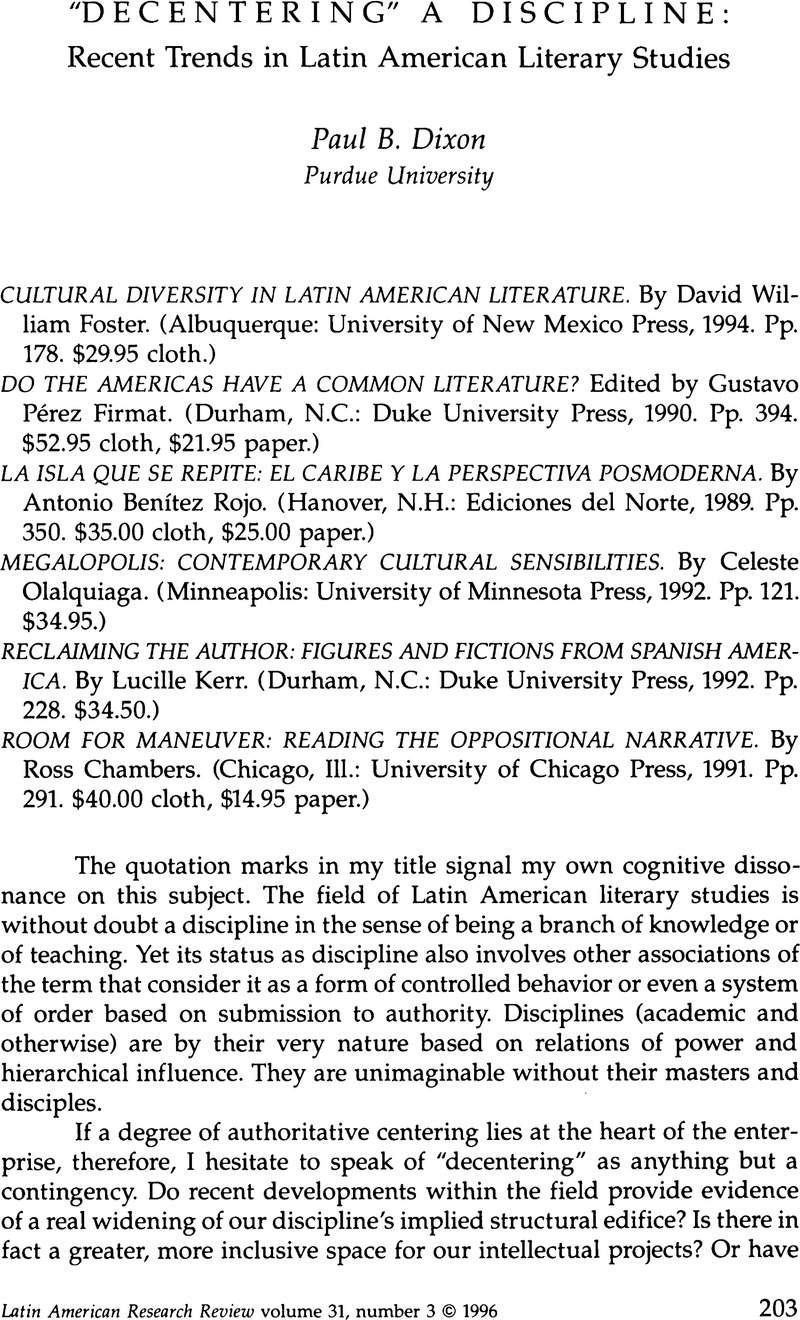No CrossRef data available.
Article contents
“Decentering” A Discipline: Recent Trends in Latin American Literary Studies
Review products
Published online by Cambridge University Press: 05 October 2022
Abstract

- Type
- Review Essays
- Information
- Copyright
- Copyright © 1996 by the University of Texas Press
References
1. A few of the most recent studies include Ileana Rodríguez, House/Garden/Nation: Space, Gender, and Ethnicity in Post-Colonial Latin American Literature by Women (Durham, N.C.: Duke University Press, 1994); Marjorie Agosín, Las hacedoras: Mujer, imagen, escritura (Santiago, Chile: Cuarto Propio, 1993); Debra A. Castillo, Talking Back: Toward a Latin American Feminist Literary Criticism (Ithaca, N.Y.: Cornell University Press, 1992); Susan Quinlan, The Female Voice in Contemporary Brazilian Narrative (New York: Peter Lang, 1991); and Splintering Darkness: Latin American Women Writers in Search of Themselves, edited by Lucia Guerra-Cunningham (Pittsburgh, Pa.: Latin American Literary Review Press, 1990).
2. See Naomi Lindstrom, Argentine-Jewish Writers (Columbia: University of Missouri Press, 1989); Saúl Sosnowski, La orilla inminente: Escritores judíos argentinos (Buenos Aires: Legasa, 1987); Paul Julian Smith, Representing the Other: “Race,” Text, and Gender in Spanish and Spanish American Narrative (New York: Oxford University Press, 1992); Lourdes Martínez-Echazabal, Para una semiótica de la mulatez (Madrid: Porrúa, 1990); and Ernestino Avendano de Vargas, Mestizaje en la literatura iberoamericana a partir de la raíz aborigen (San Juan, Argentina: Departamento de Historia y Geografía, Universidad Nacional de San Juan, 1989); and Zill Bernd, Negritude e literatura na América Latina (Porto Alegre: Mercado Aberto, 1987).
3. Consider for example, David William Foster, Gay and Lesbian Themes in Latin American Literature (Austin: University of Texas Press, 1991); Luis Gregorich, Literatura y homosexualidad y otros ensayos (Buenos Aires: Legasa, 1985); and Richard G. Parker, Bodies, Pleasures, and Passions: Sexual Culture in Contemporary Brazil (Boston, Mass.: Beacon, 1990).
4. Recent books include Paul B. Dixon, Reversible Readings: Ambiguity in Four Modern Latin American Novels (Tuscaloosa: University of Alabama Press, 1985); David William Foster, Alternative Voices in Contemporary Latin American Narrative (Columbia: University of Missouri Press, 1985); Earl E. Fitz and Judith A. Payne, Ambiguity and Gender in the New Novel of Brazil and Spanish America: A Comparative Assessment (Iowa City: University of Iowa Press, 1993); Alfred J. MacAdam, Textual Confrontations: Comparative Readings in Latin American Literature (Chicago, Ill.: University of Chicago Press, 1987); Leopoldo Bernucci, Historia de un malentendido: Un estudio transtextual de La guerra del fin del mundo de Mario Vargas Llosa (New York: Peter Lang, 1989); Anselmo F. Amaral, As origens do gaúcho na temática de Martín Fierro: Ensaio crítico (Porto Alegre: Martins, 1988); David Arrigucci, Jr., Enigma e comentário: Ensaios sobre literatura e experiência (São Paulo: Companhia das Letras, 1987); and João Alexandre Barbosa, Transformations of Literary Language in Latin American Literature: From Machado de Assis to the Vanguards (Austin, Tex.: Abaporu, 1987).
5. Readers may consult Mary Louise Pratt, Imperial Eyes: Travel Writing and Transculturation (London: Routledge, 1992); Earl E. Fitz, Rediscovering the New World: Inter-American Literature in a Comparative Context (Iowa City: University of Iowa Press, 1991); Barbara J. Webb, Myth and History in Caribbean Fiction: Alejo Carpentier, Wilson Harris, and Edouard Glissant (Amherst: University of Massachusetts Press, 1992); Simon Gikandi, Writing in Limbo: Modernism and Caribbean Literature (Ithaca, N.Y.: Cornell University Press, 1992); and Marta Ester Sánchez, Contemporary Chicana Poetry: A Critical Approach to an Emerging Literature (Berkeley and Los Angeles: University of California Press, 1985).
6. These include Charles A. Perrone, Masters of Contemporary Brazilian Song: MPB, 1965–1985 (Austin: University of Texas Press, 1989); and Claudia Schaefer, Textured Lives: Women, Art, and Representation in Modern Mexico (Tucson: University of Arizona Press, 1992).
7. For a general discussion, see Elzbieta Sklodowska, Testimonio hispanoamericano: Historia, teoría, poética (New York: Peter Lang, 1992).
8. For example, see Octavio Paz, Convergences: Essays on Art and Literature, translated by Helen Lane (San Diego, Calif.: Harcourt, 1987); John Beverley, Against Literature (Minneapolis: University of Minnesota Press, 1993); and Luiz Costa Lima, Control of the Imaginary: Reason and Imagination in Modern Times, translated by Ronald Sousa (Minneapolis: University of Minnesota Press, 1988).




